Challenge your students to solve these colourful escape room puzzles
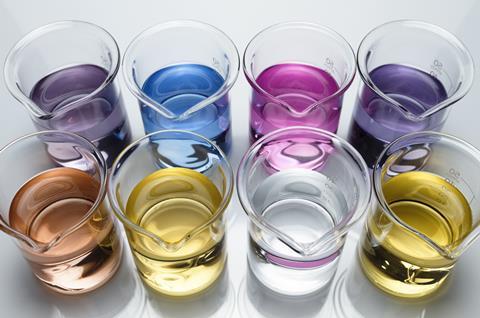
In this escape room article, students explore colour change reactions to reveal hidden codes.
If you want to use the codes to reveal a reward, a cheaper alternative to multiple locks and boxes is to use an online form such as a Google form. When a student enters the correct code, a new page for the next puzzle is revealed. The final code reveals the combination for a lock to the reward-containing box.
You will need to either write the code on a piece of card with a highlighter pen or print it in the right colour to be hidden by the solution. If you prefer, the card can be laminated. Then tape the card to the underside of a beaker. It may take a little trial and error to get the correct colour, volume and concentration of solution to hide the code.
If you use pH indicator to hide a code, to get the solution dark enough you will need more drops of indicator than you would normally use for a titration.
Puzzle 1 – Effervescent enigma
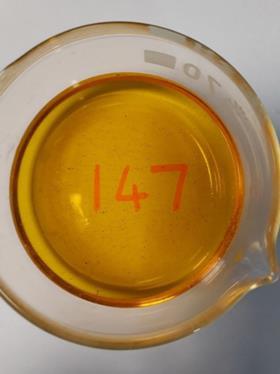
Write the code in light pink highlighter pen. Add 0.1 M hydrochloric acid and methyl orange indicator to a beaker, which will give a dark pink colour and hide the code.
Provide students with four white solids: the bicarbonate of soda that they need and three others, such as salt, sugar and citric acid, so they have to work out that only the metal carbonate will react with the acid.
When students add a spatula of the bicarbonate of soda to the beaker, the solution will produce carbon dioxide, fizz and turn the indicator yellow, which will reveal the hidden code. Take care the students do not add too much solid as a cloudy saturated solution will obscure the code.
Puzzle 2 – Reduction revelation
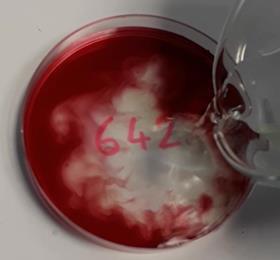
Write the code in pink. Add acidified potassium permanganate (VII) solution (0.001 M) to a beaker and the purple colour will hide the code.
Get students to add solid iron (II) sulfate or a few millilitres of 10% iron sulfate solution to the beaker; this will reduce the manganate ions to manganese ions and make the solution colourless, revealing the code.
You can perform a similar reaction using rhubarb sticks, which contain oxalic acid that can reduce and decolourise potassium manganate (VII) solution. The activity can be used to show students how the rate of reaction is affected by surface area or concentration.
Puzzle 3 – Vitamin vexation
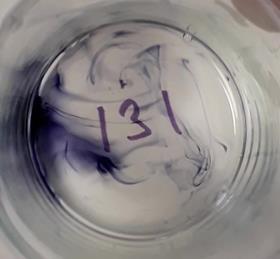
Write the code in dark blue. Add a few drops of iodine and 1% starch solution to a beaker of water until the blue/black iodine/starch complex obscures the writing.
To solve the puzzle, students should add vitamin C as a solid or in solution (also known as ascorbic acid). When the vitamin C has reduced all the iodine molecules to iodide ions, the solution will turn colourless.
As an alternative to vitamin C, students can use the juice from an orange. They may need to filter the juice as unfiltered juice can cause the solution to become too cloudy to see the code.If you provide other fruits and vegetables with some clues, the students can work out which one they need to extract juice from to cause the colour change.
You could provide a follow-up activity for students to compare the vitamin C levels in juices and/or food.
Puzzle 4 – Basic bamboozler

Place 0.1 M sodium hydroxide solution in a beaker and add a few drops of phenolphthalein indicator to give a pink colour, which will hide the code written underneath in pink.
Students can add 0.1 M hydrochloric acid to neutralise the sodium hydroxide and the pH indicator will turn colourless, revealing the code.
You can provide water, salt solution and sodium carbonate solution as red herrings. Only provide small volumes of solution, otherwise the code may be revealed by dilution with the incorrect solution rather than by a chemical reaction.
Puzzle 5 – Titration teaser
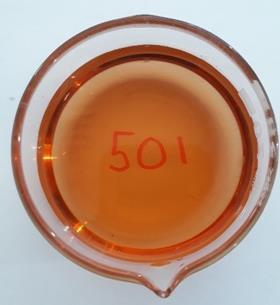
Add 0.1 M hydrochloric acid and 5–10 drops of methyl red and phenolphthalein indicator to a beaker. This will give a pinkish-red colour that will hide a code written in pink highlighter pen.
Students should carefully add 0.1 M sodium hydroxide from a burette or a dropper. This requires patience and dexterity; if too much sodium hydroxide is added the endpoint may be missed and the code will not appear.
Once added, the sodium hydroxide will begin to neutralise the acid and increase the pH. When the pH reaches 4.4, the methyl red in the solution will change to an orangey-yellow colour and the pink code will be visible.
The phenolphthalein in the solution will stay colourless until the pH reaches 8.2, when the solution will turn pink and hide the code again. You can provide 0.1 M hydrochloric acid, dropping pipettes and pH paper so students can monitor if they have added too much acid or base and adjust the pH accordingly to see the code.
Many thanks to Iain Smellie, Iain Patterson and Kevin Jones at the University of St Andrews for kindly developing and sharing their activities using pH indicators, acids, bases and highlighter pens to reveal messages.
Downloads
Escape the classroom - colour changes
PowerPoint, Size 0.84 mbEscape the classroom - colour changes
PDF, Size 0.2 mb
Escape the classroom

Be inspired to design an escape room experience for students with these chemistry related puzzles
- 1
- 2
- 3
- 4
- 5
- 6
 Currently
reading
Currently
reading
Colour changes






















No comments yet